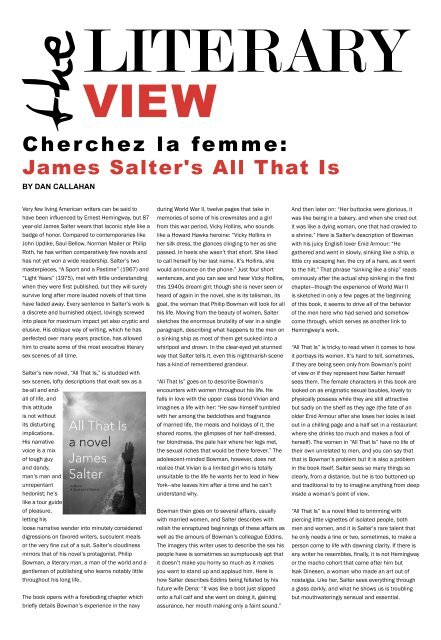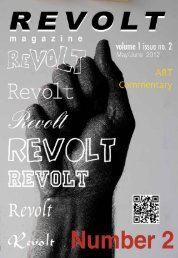Download PDF Version Revolt Magazine, Volume 1 Issue No.4
Download PDF Version Revolt Magazine, Volume 1 Issue No.4
Download PDF Version Revolt Magazine, Volume 1 Issue No.4
Create successful ePaper yourself
Turn your PDF publications into a flip-book with our unique Google optimized e-Paper software.
THE<br />
LITERARY<br />
VIEW<br />
Cherchez la femme:<br />
James Salter's All That Is<br />
BY DAN CALLAHAN<br />
Very few living American writers can be said to<br />
have been influenced by Ernest Hemingway, but 87<br />
year-old James Salter wears that laconic style like a<br />
badge of honor. Compared to contemporaries like<br />
John Updike, Saul Bellow, Norman Mailer or Philip<br />
Roth, he has written comparatively few novels and<br />
has not yet won a wide readership. Salter’s two<br />
masterpieces, “A Sport and a Pastime” (1967) and<br />
“Light Years” (1975), met with little understanding<br />
when they were first published, but they will surely<br />
survive long after more lauded novels of that time<br />
have faded away. Every sentence in Salter’s work is<br />
a discrete and burnished object, lovingly screwed<br />
into place for maximum impact yet also cryptic and<br />
elusive. His oblique way of writing, which he has<br />
perfected over many years practice, has allowed<br />
him to create some of the most evocative literary<br />
sex scenes of all time.<br />
Salter’s new novel, “All That Is,” is studded with<br />
sex scenes, lofty descriptions that exalt sex as a<br />
be-all and endall<br />
of life, and<br />
this attitude<br />
is not without<br />
its disturbing<br />
implications.<br />
His narrative<br />
voice is a mix<br />
of tough guy<br />
and dandy,<br />
man’s man and<br />
unrepentant<br />
hedonist; he’s<br />
like a tour guide<br />
of pleasure,<br />
letting his<br />
loose narrative wander into minutely considered<br />
digressions on favored writers, succulent meals<br />
or the very fine cut of a suit. Salter’s cloudiness<br />
mirrors that of his novel’s protagonist, Philip<br />
Bowman, a literary man, a man of the world and a<br />
gentleman of publishing who learns notably little<br />
throughout his long life.<br />
The book opens with a foreboding chapter which<br />
briefly details Bowman’s experience in the navy<br />
during World War II, twelve pages that take in<br />
memories of some of his crewmates and a girl<br />
from this war period, Vicky Hollins, who sounds<br />
like a Howard Hawks heroine: “Vicky Hollins in<br />
her silk dress, the glances clinging to her as she<br />
passed. In heels she wasn’t that short. She liked<br />
to call herself by her last name. It’s Hollins, she<br />
would announce on the phone.” Just four short<br />
sentences, and you can see and hear Vicky Hollins,<br />
this 1940s dream girl; though she is never seen or<br />
heard of again in the novel, she is its talisman, its<br />
goal, the woman that Philip Bowman will look for all<br />
his life. Moving from the beauty of women, Salter<br />
sketches the enormous brutality of war in a single<br />
paragraph, describing what happens to the men on<br />
a sinking ship as most of them get sucked into a<br />
whirlpool and drown. In the clear-eyed yet stunned<br />
way that Salter tells it, even this nightmarish scene<br />
has a kind of remembered grandeur.<br />
“All That Is” goes on to describe Bowman’s<br />
encounters with women throughout his life. He<br />
falls in love with the upper class blond Vivian and<br />
imagines a life with her: “He saw himself tumbled<br />
with her among the bedclothes and fragrance<br />
of married life, the meals and holidays of it, the<br />
shared rooms, the glimpses of her half-dressed,<br />
her blondness, the pale hair where her legs met,<br />
the sexual riches that would be there forever.” The<br />
adolescent-minded Bowman, however, does not<br />
realize that Vivian is a limited girl who is totally<br />
unsuitable to the life he wants her to lead in New<br />
York—she leaves him after a time and he can’t<br />
understand why.<br />
Bowman then goes on to several affairs, usually<br />
with married women, and Salter describes with<br />
relish the enraptured beginnings of these affairs as<br />
well as the amours of Bowman’s colleague Eddins.<br />
The imagery this writer uses to describe the sex his<br />
people have is sometimes so sumptuously apt that<br />
it doesn’t make you horny so much as it makes<br />
you want to stand up and applaud him. Here is<br />
how Salter describes Eddins being fellated by his<br />
future wife Dena: “It was like a boot just slipped<br />
onto a full calf and she went on doing it, gaining<br />
assurance, her mouth making only a faint sound.”<br />
And then later on: “Her buttocks were glorious, it<br />
was like being in a bakery, and when she cried out<br />
it was like a dying woman, one that had crawled to<br />
a shrine.” Here is Salter’s description of Bowman<br />
with his juicy English lover Enid Armour: “He<br />
gathered and went in slowly, sinking like a ship, a<br />
little cry escaping her, the cry of a hare, as it went<br />
to the hilt.” That phrase “sinking like a ship” reads<br />
ominously after the actual ship sinking in the first<br />
chapter—though the experience of World War II<br />
is sketched in only a few pages at the beginning<br />
of this book, it seems to drive all of the behavior<br />
of the men here who had served and somehow<br />
come through, which serves as another link to<br />
Hemingway’s work.<br />
“All That Is” is tricky to read when it comes to how<br />
it portrays its women. It’s hard to tell, sometimes,<br />
if they are being seen only from Bowman’s point<br />
of view or if they represent how Salter himself<br />
sees them. The female characters in this book are<br />
looked on as enigmatic sexual baubles, lovely to<br />
physically possess while they are still attractive<br />
but sadly on the shelf as they age (the fate of an<br />
older Enid Armour after she loses her looks is laid<br />
out in a chilling page and a half set in a restaurant<br />
where she drinks too much and makes a fool of<br />
herself). The women in “All That Is” have no life of<br />
their own unrelated to men, and you can say that<br />
that is Bowman’s problem but it is also a problem<br />
in the book itself. Salter sees so many things so<br />
clearly, from a distance, but he is too buttoned-up<br />
and traditional to try to imagine anything from deep<br />
inside a woman’s point of view.<br />
“All That Is” is a novel filled to brimming with<br />
piercing little vignettes of isolated people, both<br />
men and women, and it is Salter’s rare talent that<br />
he only needs a line or two, sometimes, to make a<br />
person come to life with dawning clarity. If there is<br />
any writer he resembles, finally, it is not Hemingway<br />
or the macho cohort that came after him but<br />
Isak Dinesen, a woman who made an art out of<br />
nostalgia. Like her, Salter sees everything through<br />
a glass darkly, and what he shows us is troubling<br />
but mouthwateringly sensual and essential.





